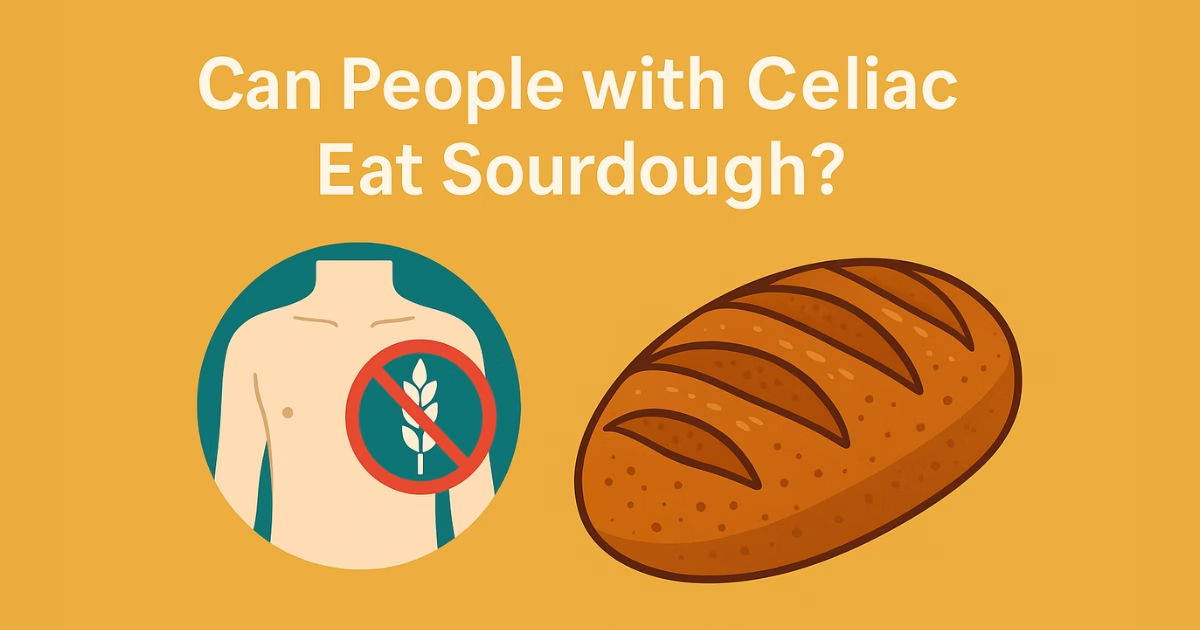Celiac disease is a serious autoimmune disorder that affects how the body reacts to gluten. For people with this condition, even a small amount of gluten can cause damage to the small intestine. Bread, being a common source of gluten, is often off-limits. But sourdough bread sparks debate. Its natural fermentation process makes some believe it might be easier to digest or even low in gluten. That brings up an important question—can people with celiac eat sourdough safely? This blog post takes a deep dive into that very topic. We’ll break down the science, expert advice, and real-world stories to help you decide if sourdough has a place in a gluten-free lifestyle. If you’ve been wondering whether sourdough is safe or risky, you’re in the right place.
Can People with Celiac Eat Sourdough?
This question doesn’t have a simple yes or no answer. It really depends on the type of sourdough and the severity of a person’s celiac condition. Traditional sourdough bread is made through fermentation, which does reduce gluten to some extent. But “reduced” doesn’t mean “removed.” Most regular sourdough still contains enough gluten to trigger symptoms in someone with celiac disease.
The confusion often comes from the fact that sourdough is easier to digest for some people with gluten sensitivity. But celiac disease is not the same as gluten sensitivity. For someone with celiac, even a tiny bit of gluten can be harmful, even if there are no immediate symptoms. That’s why most experts warn against eating traditional sourdough unless it’s clearly labeled as gluten-free.
So, the short answer? Most people with celiac should not eat regular sourdough bread. Gluten-free sourdough, on the other hand, may be safe—but only if it’s certified.
What Is Celiac Disease?
Celiac disease is not just a food allergy or a mild stomach issue. It’s an autoimmune condition. When someone with celiac eats gluten, their immune system attacks the small intestine. This can damage the villi—tiny finger-like structures that help absorb nutrients. Without healthy villi, the body can’t take in essential vitamins and minerals.
Gluten is found in wheat, barley, and rye. That means many common foods like bread, pasta, and baked goods can be dangerous for someone with celiac. The damage might not always cause obvious symptoms right away. But over time, it can lead to serious health problems—things like anemia, bone loss, or even fertility issues.
The only way to manage celiac is to completely avoid gluten. There’s no cure or medicine to fix it. That’s why people with this disease have to be extra careful about everything they eat, including sourdough.
What Makes Sourdough Different from Regular Bread?
Sourdough isn’t your typical loaf of bread. It’s made through a natural fermentation process using wild yeast and bacteria. Instead of using commercial yeast, sourdough starts with a “starter”—a mix of flour and water that ferments over time. This starter creates gases that make the dough rise and gives sourdough its tangy taste.
But there’s more to sourdough than flavor. During fermentation, some of the gluten proteins start breaking down. This happens because of enzymes created by the bacteria and yeast. The result? A bread that’s often easier to digest for some people—especially those with non-celiac gluten sensitivity.
Still, it’s important to know that sourdough made from wheat flour still contains gluten. Even though the fermentation process lowers the amount, it doesn’t remove it entirely. For people with celiac disease, that small amount can still be harmful.
Does Sourdough Contain Gluten?
Yes, most sourdough bread still contains gluten. That’s the simple truth. Unless it’s made from certified gluten-free flour, it’s not safe for people with celiac. The natural fermentation process can reduce gluten levels, but it doesn’t get rid of them.
Some studies have looked into this. One test showed that sourdough fermentation could lower gluten content to under 20 parts per million (ppm)—which is the legal limit for gluten-free labeling in the U.S. But that doesn’t mean every loaf of sourdough will meet that standard. There are too many variables: the type of flour, the length of fermentation, and the skill of the baker.
Also, not all labs agree on how to measure gluten in fermented foods. That makes it hard to be 100% sure whether a sourdough is safe or not. Unless it says “gluten-free” on the label, it’s best for someone with celiac to stay away.
Expert Opinions: Is It Safe or Risky?
Doctors and celiac specialists mostly agree—regular sourdough is risky for people with celiac disease. Even though the fermentation process can reduce gluten, it doesn’t eliminate it. According to the Celiac Disease Foundation, products made from wheat, barley, or rye should always be avoided unless they’re labeled gluten-free.
The FDA also has strict guidelines. For a food to be labeled gluten-free, it must contain less than 20 ppm of gluten. Regular sourdough doesn’t meet this unless it’s made from certified gluten-free ingredients.
Some people claim they feel fine after eating sourdough, even with celiac. But experts warn against trusting how you “feel” as a sign of safety. The damage can still happen on the inside, even if you don’t have symptoms right away.
In short, most professionals don’t recommend traditional sourdough for celiacs.
Gluten-Free Sourdough: A Safer Option
Luckily, there’s a safer choice—gluten-free sourdough. This type of bread uses gluten-free grains like brown rice, buckwheat, sorghum, millet, or teff. These flours don’t contain gluten at all. When combined with the sourdough fermentation process, they make a bread that’s both tasty and safe.
Gluten-free sourdough still goes through natural fermentation, so it has the same tangy flavor and soft texture. But since it doesn’t use wheat or rye, it doesn’t carry the same risks. Just make sure it’s labeled “certified gluten-free.”
Many bakeries now specialize in gluten-free products. You can find gluten-free sourdough at health food stores or order it online. Always read labels carefully. Look for certifications and avoid breads made in shared kitchens where cross-contamination might happen.
What Celiacs Say: Real-Life Experiences
Online forums and support groups are full of stories from people with celiac who tried sourdough. The results are mixed. Some say they felt okay eating a slice or two of regular sourdough. Others report getting very sick—even from just a bite.
One woman said she had no symptoms after eating artisanal sourdough from a local bakery. But after a medical checkup, doctors found inflammation in her gut. Another man thought sourdough was fine until he ended up with stomach pain and fatigue.
These stories show why it’s not worth the risk. Even if someone doesn’t feel symptoms, damage can still occur silently. People with celiac can’t afford to guess when it comes to food. The best advice? Always choose certified gluten-free bread—and speak with a healthcare provider before trying anything new.
How to Make Gluten-Free Sourdough at Home
Making gluten-free sourdough at home takes patience, but it’s rewarding. You start by making a starter using gluten-free flour and water. Mix them in a clean jar and let them sit at room temperature. Feed the mixture daily by discarding half and adding more flour and water. In about 5–7 days, it will bubble and smell sour—that means it’s ready.
To make the bread, mix the starter with more gluten-free flour, water, a little salt, and oil. Let it rise for several hours, then bake it. The result? A loaf that’s soft, slightly tangy, and totally safe.
Always use tools and surfaces that haven’t touched gluten. Even a small trace of wheat flour can cause issues. Stick to certified gluten-free ingredients and follow recipes designed for celiacs. There are plenty of online guides and books dedicated to this kind of baking.
Other Bread Alternatives for Celiacs
If sourdough isn’t your thing, don’t worry—there are plenty of other options. Gluten-free bread brands are everywhere now. Many use ingredients like tapioca starch, potato flour, quinoa, and almond flour.
Some popular gluten-free bread brands include:
- Udi’s
- Canyon Bakehouse
- Schär
- Little Northern Bakehouse
You can also try grain-free breads, like those made with coconut flour or cassava. These are great for people who react to even gluten-free grains.
While gluten-free bread can sometimes taste different, many brands have improved in recent years. Some even offer gluten-free sourdough or multigrain loaves that are rich in flavor and fiber.
Final Verdict: Should Celiacs Eat Sourdough?
So, back to the main question: can people with celiac eat sourdough? The answer is mostly no—unless the sourdough is made from certified gluten-free ingredients.
Traditional sourdough bread, even though it goes through fermentation, still contains gluten. That means it’s not safe for people with celiac disease. The risks are too high, and the damage can be invisible. Just feeling okay isn’t enough to say it’s safe.
On the other hand, gluten-free sourdough is a good alternative. It gives you that same sour flavor without the danger. But it has to be made in a gluten-free environment and clearly labeled as such.
It’s always best to talk to a doctor or dietitian before trying new foods if you have celiac. Being careful isn’t overreacting—it’s protecting your health.
Conclusion
Celiac disease requires strict attention to food choices, and bread is one of the biggest concerns. Although sourdough is often praised for being easier to digest, that doesn’t make it safe for everyone. If you’re asking, can people with celiac eat sourdough, the safest answer is no—unless it’s gluten-free and clearly labeled.
The science behind sourdough is fascinating. Fermentation does lower gluten levels, but not enough to guarantee safety. Some celiacs may not feel symptoms right away, but internal damage can still happen.
Gluten-free sourdough, made from safe grains, offers a good compromise. With care and attention, even those with celiac can enjoy bread again. Just be smart, read labels, and when in doubt—leave it out.

Hi, I’m Shafy Ali – a curious mind and passionate writer at Celiac Magazine. I cover a little bit of everything, from everyday tips and how-tos to deeper dives into topics that spark conversation. I enjoy turning research into readable, relatable content that informs and inspires. Whatever the subject, I aim to keep it clear, engaging, and genuinely useful.

